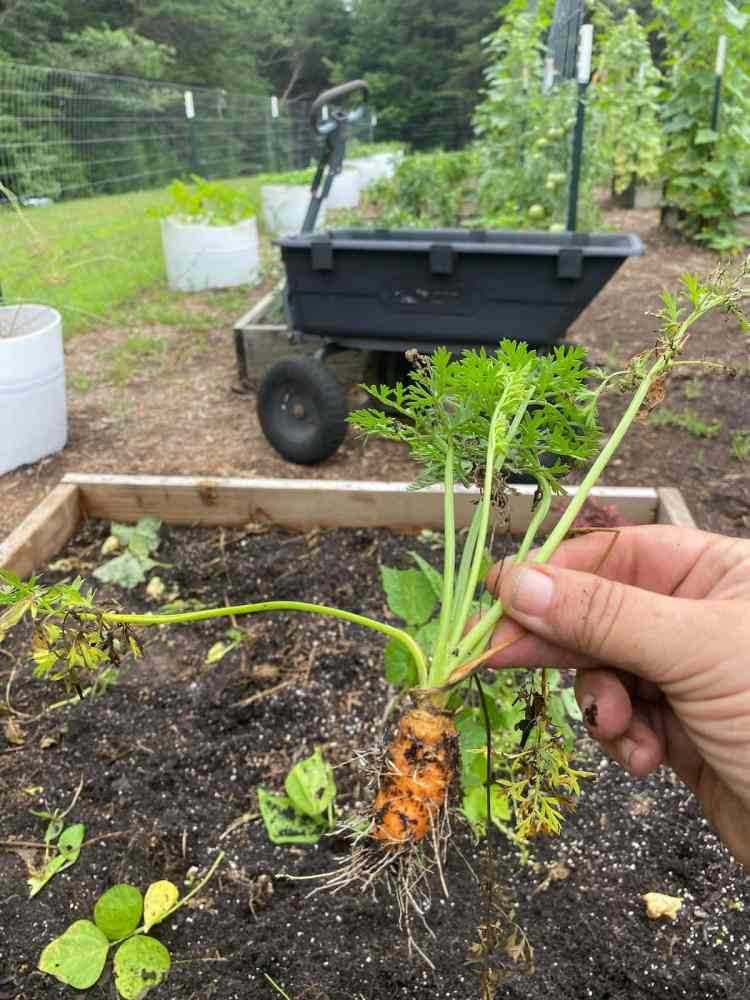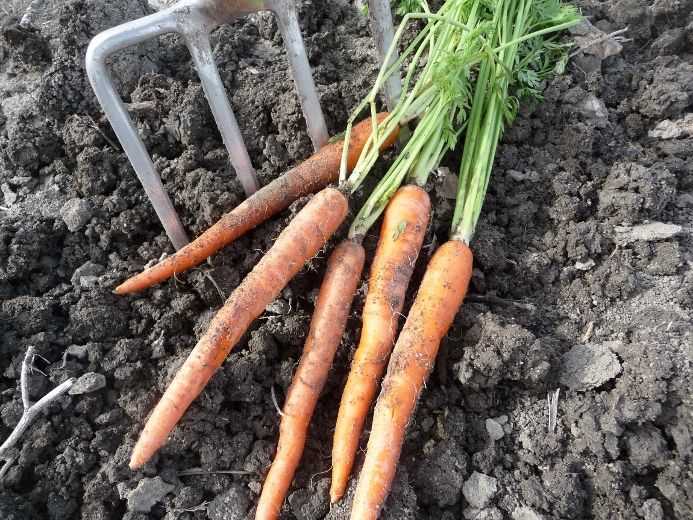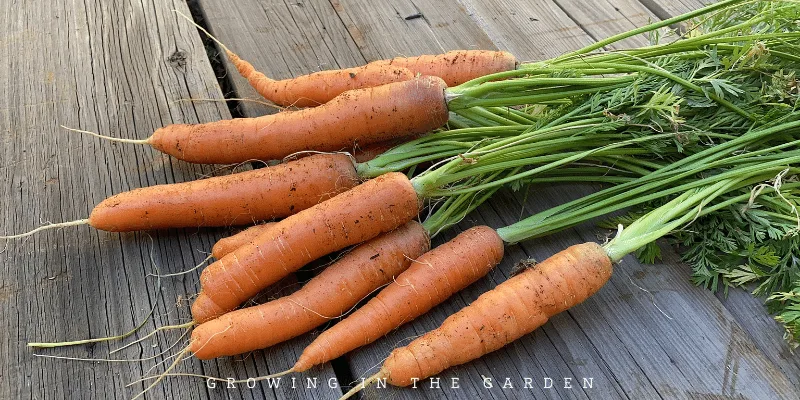- The Importance of Proper Watering for Growing Carrots
- Timing
- Frequency
- Method
- Soil Considerations
- Conclusion
- Optimal Fertilization Techniques for Carrot Growth
- Soil Testing
- Organic Matter
- Balanced Fertilizers
- Timing
- Application Methods
- Watering
- Monitoring and Adjusting
- Signs to Look for When Carrots Have Had Enough Water
- When and How to Stop Watering Carrots for Optimal Growth
- 1. Monitor Soil Moisture:
- 2. Adjust Watering Frequency:
- 3. Watering Depth:
- 4. Mulching:
- 5. Time of Day:
- Determining the Right Time to Stop Fertilizing Carrots
- 1. Carrot Variety
- 2. Growth Stage
- 3. Soil Nutrient Levels
- 4. Fertilizer Application Schedule
- 5. Visual Signs
- The Effects of Over-Watering and Over-Fertilizing on Carrot Plants
- Over-Watering
- Over-Fertilizing
- Conclusion
- Proper Storage Methods to Preserve the Freshness of Carrots
- 1. Harvesting and Cleaning:
- 2. Drying:
- 3. Choose the Right Storage Method:
- 4. Check for Spoilage:
- 5. Utilize Potatoes:
- The Ideal Conditions for Storing Carrots to Prolong Their Shelf Life
- Temperature and Humidity
- Light Exposure
- Storage Containers
- Handling and Maintenance
- “Question-Answer”
- When is the best time to stop watering carrots?
- How often should I fertilize my carrots?
- What are the signs that carrots are ready to be harvested?
- What is the best method for storing carrots?
- Can I save carrot seeds for future planting?
- “Video” Growing Lots of Carrots in Small Raised Bed Plus Tips!
Growing carrots can be a rewarding endeavor, but achieving the perfect crop requires careful attention to detail. One of the most crucial aspects is knowing when to stop watering and fertilizing. While it may seem counterintuitive, overwatering can actually hinder carrot growth and lead to inferior produce. By understanding the subtleties of carrot care, you can ensure a bountiful harvest.
Carrots thrive in well-drained soil, and excessive watering can cause the roots to become waterlogged. This can lead to rot and hinder root development. It’s important to strike a balance, providing enough moisture for the carrots to grow, but not so much that it becomes detrimental. Monitoring the soil moisture levels and adjusting watering accordingly is key.
Similarly, fertilizing carrots requires a delicate touch. While it’s important to provide nutrients for the plants to thrive, over-fertilization can lead to excessive foliage growth at the expense of root development. Carrots require a balanced fertilizer with a higher concentration of phosphorus, which promotes root growth. However, too much nitrogen can lead to excessive foliage and misshapen roots. Regular soil testing can help determine the optimal fertilizer application.
Note: The key is to fertilize sparingly and at the right time, ensuring that the nutrients are available when the plants need them most. It’s important to follow the recommended guidelines for your specific carrot variety and soil conditions.
Once your carrots are ready for harvest, knowing the best storage methods is essential to preserve their flavor and texture. Carrots can be stored in the refrigerator, but there are a few tricks to keeping them fresh. Remove the green tops, as they can draw moisture from the roots and cause them to go limp. Store the carrots in a perforated plastic bag to allow for proper airflow, and avoid storing them near fruits that release ethylene gas, as it can cause the carrots to spoil more quickly. With proper storage, your homegrown carrots can last for several weeks, allowing you to enjoy their sweetness throughout the season.
The Importance of Proper Watering for Growing Carrots
Watering is a crucial aspect of growing carrots as it directly affects their growth and quality. Proper watering ensures that the carrots receive the necessary moisture for healthy development.
Timing
One important aspect of watering carrots is timing. It’s essential to water them at the right time to provide sufficient moisture without overwatering. Carrots need consistent, regular watering throughout their growth cycle.
To determine when to water your carrots, monitor the soil moisture. Stick your finger about an inch into the ground near the plants and check for moisture. If it feels dry at that depth, it’s time to water.
Frequency
The frequency of watering depends on various factors, including the climate, soil type, and stage of growth. Generally, carrots need about 1 inch of water per week, including both rainfall and irrigation.
During the germination stage, carrots should be kept moist but not waterlogged. Provide light watering a few times a week to keep the soil evenly damp. As the plants mature and develop roots, increase the amount of water but avoid overwatering, as it can cause the roots to rot.
Method
The method of watering is another crucial factor. Carrots prefer deep watering rather than frequent shallow watering. Deep watering encourages the roots to grow deeper into the soil and helps the plants become more drought-tolerant.
Using a drip or soaker hose is an effective method for watering carrots. It allows the water to penetrate deep into the soil without wetting the leaves, which can lead to diseases.
Soil Considerations
The soil structure plays a significant role in watering. Well-draining soil is important for carrot growth as it prevents waterlogging, which can cause the roots to rot. If the soil is heavy and clayey, consider incorporating organic matter, such as compost, to improve drainage.
Conclusion

Proper watering is essential for growing healthy and high-quality carrots. By considering the timing, frequency, method, and soil considerations, you can provide the adequate moisture needed for carrot growth and ensure a successful harvest.
Optimal Fertilization Techniques for Carrot Growth
Fertilization plays a crucial role in the growth and development of carrots. Understanding the optimal fertilization techniques is essential for ensuring healthy and abundant carrot harvests. Here are some key factors to consider:
Soil Testing
Before applying any fertilizers, it is recommended to conduct a soil test. This will give you valuable information about the nutrient levels in your soil. Carrots generally thrive in well-drained soil with a pH level between 6.0 and 6.8. The soil test results will guide you in determining which nutrients your soil may lack and the appropriate fertilizers to use.
Organic Matter
Adding organic matter to the soil is essential for carrot growth. Compost, well-rotted manure, or leaf mold can be incorporated into the soil before planting. These amendments not only improve soil structure and drainage but also provide a slow-release source of nutrients for the carrots.
Balanced Fertilizers
Choosing a balanced fertilizer, such as a 10-10-10 or 14-14-14, can provide the essential nutrients for carrot growth. These numbers represent the percentage of nitrogen (N), phosphorus (P), and potassium (K) in the fertilizer, respectively. Carrots have specific nutrient requirements, and a balanced fertilizer can ensure that these needs are met.
Timing
Applying fertilizers at the right time is crucial for optimal carrot growth. It is generally recommended to apply fertilizers before planting and during the early stages of growth. Too much fertilizer during the later stages can result in excessive foliage growth at the expense of quality carrot root development.
Application Methods
There are various methods for applying fertilizers to carrots. Broadcasting the fertilizer evenly over the soil surface and then incorporating it into the top few inches can ensure even distribution of nutrients. Alternatively, banding the fertilizer in rows along the sides of the carrot rows can allow for more targeted nutrient delivery.
Watering

Proper watering is essential for the uptake of nutrients by carrot plants. Overwatering can lead to leaching of nutrients, while underwatering can hinder nutrient absorption. It is important to maintain consistent moisture levels in the soil, allowing the carrots to access the nutrients to support their growth.
Monitoring and Adjusting
Regular monitoring of the carrot plants’ growth and appearance can help identify any nutrient deficiencies or excesses. Adjust the fertilization practices accordingly based on the observed signs. Remember that it is crucial to follow the recommended fertilization rates and avoid over-fertilization, as this can cause harm to the carrots and the environment.
By adopting these optimal fertilization techniques, you can provide the necessary nutrients for your carrots’ growth and development, leading to healthy plants and a bountiful harvest.
Signs to Look for When Carrots Have Had Enough Water
As a carrot grower, it is important to know when your carrots have had enough water. Overwatering can lead to a number of issues, such as rotting, splitting, and poor taste. Below are some signs to look for to determine if your carrots have had enough water:
- Soil Moisture: Check the moisture level of the soil around your carrots. If the soil feels consistently wet or waterlogged, it may be a sign of overwatering. Carrots prefer well-drained soil, so ensure that the soil does not stay overly moist for extended periods.
- Yellowing Leaves: Examine the foliage of your carrot plants. If the leaves are turning yellow or have a wilted appearance, it could indicate overwatering. Carrots require some moisture but can be sensitive to excess water, leading to root damage.
- Stunted Growth: If your carrots are not growing as expected or are smaller in size than usual, it may be a result of overwatering. Too much water can hinder root development and limit overall growth.
- Root Rot: Overwatered carrots are susceptible to root rot, which is characterized by a foul smell, darkened roots, and a mushy texture. If you notice any of these signs, it is important to address the issue promptly.
It is important to strike a balance when watering your carrots. Be mindful of the weather conditions and adjust your watering schedule accordingly. Proper drainage and regular monitoring of soil moisture levels will help ensure that your carrots receive the right amount of water for optimal growth.
When and How to Stop Watering Carrots for Optimal Growth

Knowing when to stop watering your carrots is crucial for ensuring their optimal growth. While carrots need regular watering to thrive, excess water can lead to rotting, split roots, and a decrease in flavor. This article will guide you on when and how to stop watering your carrots.
1. Monitor Soil Moisture:
Regularly check the moisture level of the soil. Carrots require consistently moist soil but not waterlogged conditions. Insert your finger about an inch into the soil. If it feels dry, it’s time to water. If it feels moist, hold off on watering for a bit.
2. Adjust Watering Frequency:
As the carrot plants grow, the frequency of watering may change. In the early stages, when the seeds are germinating and the seedlings are young, they require more frequent irrigation. However, as the carrots mature and develop a deep root system, reduce the frequency of watering to prevent overwatering.
3. Watering Depth:

While the frequency of watering may decrease as the carrots grow, it’s important to maintain a deep watering routine. Water should penetrate at least 6-8 inches deep to ensure the roots receive adequate moisture. Shallow watering can cause the top layer to dry out quickly while leaving the deeper roots thirsty.
4. Mulching:
Applying a layer of mulch around the base of the carrot plants can help retain moisture in the soil. Mulch acts as a barrier, reducing evaporation and keeping the soil consistently moist. This can help decrease the watering frequency while still providing enough moisture for the carrots to grow.
5. Time of Day:
Avoid watering your carrots during the hottest parts of the day as the water can quickly evaporate before reaching the roots. Instead, water in the early morning or late afternoon when the temperatures are cooler, allowing the water to penetrate the soil adequately.
By monitoring soil moisture, adjusting watering frequency, watering deeply, using mulch, and choosing the right time of the day, you can stop watering your carrots at the right time and ensure optimal growth. Remember, finding the balance between too much and too little water is essential for healthy carrot development.
Determining the Right Time to Stop Fertilizing Carrots
Fertilizing is an important part of growing carrots, but it’s crucial to know when to stop. Over-fertilizing can lead to excessive foliage growth and small, misshapen carrots. Here are some factors to consider when determining the right time to stop fertilizing carrots:
1. Carrot Variety
The first thing to consider is the specific carrot variety you are growing. Different varieties have different growth habits and nutrient requirements. Some varieties may require more frequent or higher doses of fertilizer, while others may need less.
2. Growth Stage
Pay attention to the growth stage of your carrots. Carrots generally require more fertilizer during the early growth stages to support foliage development. As the carrots mature, the focus shifts to root development. At this point, reducing or stopping fertilization can help carrots allocate more energy to root growth.
3. Soil Nutrient Levels
Test your soil nutrient levels regularly to determine if further fertilization is necessary. Soil that has adequate nutrient levels may not require additional fertilizer. Testing can help you make informed decisions about when to stop adding fertilizers to your carrot patch.
4. Fertilizer Application Schedule
If you have been following a regular fertilizer application schedule, it is important to stick to the recommended timeline. Most fertilizers have specific guidelines regarding the frequency and timing of application. Following these guidelines can help prevent over-fertilization and ensure optimal carrot growth.
5. Visual Signs
Lastly, keep an eye out for visual signs that your carrots have received enough nutrients. If the carrot foliage appears healthy and vibrant, and the carrots themselves are growing well, it may be a good indication that it’s time to stop fertilizing. However, if the foliage is excessive or the carrots are misshapen, it may be a sign of over-fertilization, and you should consider reducing or stopping fertilization.
By carefully considering these factors and closely monitoring your carrot plants, you can determine the right time to stop fertilizing. Remember, proper fertilization is crucial for healthy carrot growth, but knowing when to stop is equally important to avoid nutrient imbalances and to ensure the best quality carrots at harvest time.
The Effects of Over-Watering and Over-Fertilizing on Carrot Plants
Over-Watering
While it’s important to keep carrot plants adequately hydrated, over-watering can have detrimental effects on their growth and development. When carrot plants receive an excess amount of water, their roots become waterlogged, leading to oxygen deprivation. This lack of oxygen in the root zone can cause root rot, stunted growth, and even plant death.
Over-watering can also cause the carrot roots to crack or split. The excess water causes the roots to swell rapidly, resulting in these physical deformities. Cracked or split roots not only affect the appearance of the carrots but also make them more susceptible to diseases and decay.
To avoid over-watering carrot plants, it is essential to monitor the moisture levels in the soil. Stick your finger into the soil up to the second knuckle – if it feels moist, it means that the plants have enough water. Only water the plants when the top inch of soil feels dry.
Over-Fertilizing
While fertilizing carrot plants is necessary for their growth and nutrient intake, over-fertilizing can lead to various problems. Carrot plants require a balanced and moderate amount of nutrients to thrive. When excessive fertilizer is applied, it can disrupt the delicate nutrient balance in the soil, leading to nutrient imbalances in the plants.
Over-fertilizing can result in the excessive growth of foliage, while the development of the carrot roots is hindered. This causes the carrots to become small and stunted. Additionally, over-fertilizing can result in an increased susceptibility to pests and diseases.
To prevent over-fertilizing, it is crucial to follow the recommended application rates and schedules for the specific type of fertilizer being used. Additionally, conducting regular soil tests can help determine the nutrient levels in the soil and guide fertilizer application.
Conclusion
Proper watering and fertilizing practices are crucial for the successful growth of carrot plants. Over-watering can lead to root rot and physical deformities in the carrots, while over-fertilizing can cause stunted growth and nutrient imbalances. It is essential to monitor soil moisture levels and adhere to recommended fertilizer application rates to ensure healthy and productive carrot plants.
Proper Storage Methods to Preserve the Freshness of Carrots
Proper storage is crucial to maintain the freshness and flavor of carrots for an extended period of time. By following these storage methods, you can ensure that your carrots remain crisp and delicious for weeks or even months after harvest.
1. Harvesting and Cleaning:
Carrots should be harvested when they have reached their full size and color. Gently pull them out of the ground, taking care not to damage the roots. Remove any excess soil and trim the green tops, leaving about an inch of stem attached to the carrot.
2. Drying:

After harvesting and cleaning, it is essential to dry the carrots thoroughly before storage. Excess moisture can lead to rotting. Allow the carrots to air dry for a few hours or pat them gently with a clean cloth to remove any remaining moisture.
3. Choose the Right Storage Method:
Carrots can be stored in different ways depending on the available storage space and personal preference.
- Refrigerator: Carrots can be stored in the crisper drawer of the refrigerator. Place them in a perforated plastic bag or a container with a damp cloth to maintain moisture. They can last for up to 2 months in the refrigerator.
- Root Cellar: If you have a root cellar, it is an ideal storage option for carrots. Store them in boxes or bins filled with sand, sawdust, or peat moss to keep them cool and prevent drying. Carrots can last for several months in a root cellar.
- Freezer: Carrots can also be frozen for long-term storage. Blanch them in boiling water for a few minutes, then cool them quickly in an ice bath. Drain and transfer them to freezer bags or containers. Frozen carrots can last for up to a year.
4. Check for Spoilage:
Regularly check stored carrots for any signs of spoilage. Discard any carrots that have become soft, mushy, or have a foul odor. Removing spoiled carrots will help prevent the spread of rot to other carrots in storage.
5. Utilize Potatoes:
Placing a few potatoes near your stored carrots can help to maintain their freshness. Potatoes release a natural gas called ethylene, which slows down the spoilage process and helps to extend the shelf life of carrots.
By following these proper storage methods, you can enjoy fresh and flavorful carrots long after harvest. Whether stored in the refrigerator, root cellar, or freezer, your homegrown or store-bought carrots will remain crisp and tasty for future use.
The Ideal Conditions for Storing Carrots to Prolong Their Shelf Life
Proper storage is essential for maintaining the freshness and flavor of carrots. By providing the right conditions, you can prolong their shelf life and enjoy the sweet taste of homegrown carrots for an extended period. Here are some tips on the ideal conditions for storing carrots:
Temperature and Humidity
- Carrots should be stored in a cool and dry location, preferably between 32°F (0°C) and 40°F (4°C).
- A humidity level of around 90% is ideal for storing carrots. You can achieve this by placing the carrots in a perforated plastic bag or wrapping them in a damp cloth to maintain moisture.
- Keep carrots away from fruits such as apples and pears, as they release ethylene gas, which can cause the carrots to spoil faster.
Light Exposure
- Carrots should be stored in a dark place to prevent them from turning green or becoming bitter.
- Avoid exposing carrots to direct sunlight or bright artificial light, as this can dehydrate them and affect their flavor.
Storage Containers
- Choose a storage container that allows for good airflow, such as a perforated plastic bag, a vegetable storage bag, or a ventilated container.
- Avoid storing carrots in sealed plastic bags or airtight containers, as this can trap moisture and lead to rotting.
Handling and Maintenance
- Gently brush off any excess dirt from the carrots, but do not wash them before storage, as moisture can cause rotting.
- Inspect carrots regularly and remove any damaged or spoiled ones to prevent the spread of rot.
- If storing carrots with their tops on, remove the green foliage as it draws moisture from the root and causes wilting.
By following these guidelines, you can ensure that your homegrown carrots stay fresh and delicious for an extended period, allowing you to enjoy the bounties of your garden throughout the year.
“Question-Answer”
When is the best time to stop watering carrots?
The best time to stop watering carrots is about two to three weeks before harvest. This allows the carrots to dry out and develop a sweeter taste.
How often should I fertilize my carrots?
Carrots do not require heavy fertilization and should only be fertilized once, about four weeks after planting. Use a balanced organic fertilizer and follow the package instructions for application.
What are the signs that carrots are ready to be harvested?
The signs that carrots are ready to be harvested include their bright orange color, a smooth and firm texture, and a diameter of about 1 inch. Gently pull the carrots from the soil to avoid breaking them.
What is the best method for storing carrots?
The best method for storing carrots is to remove the green tops and store them in a perforated plastic bag in the refrigerator. Carrots can also be stored in a cool, dark place like a root cellar. Avoid storing carrots near ethylene-producing fruits and vegetables as they can cause the carrots to become bitter.
Can I save carrot seeds for future planting?
Yes, you can save carrot seeds for future planting. Allow the carrots to flower and produce seeds, then collect the dried seed heads and store them in a cool, dry place. Carrot seeds can remain viable for up to three years.







